1973 German Grand Prix race report
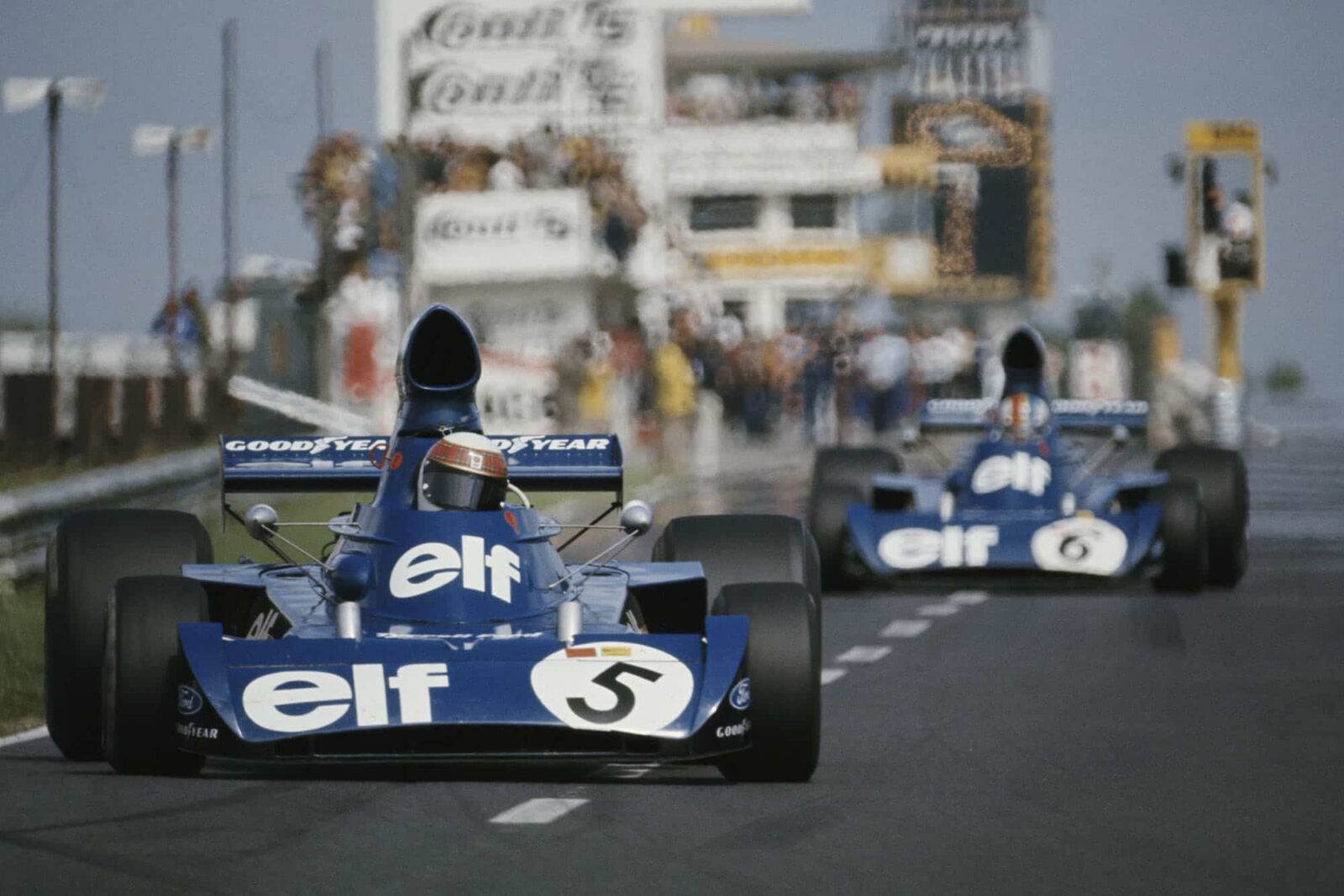
Jackie Stewart and Francois Cerevert secured a 1-2 finish for Tyrrell at the Nurburgring
Motorsport Images
A Tyrrell Demonstration
Nurburgring, Germany, August 5th
With practice for the German Grand Prix on the Nurburgring starting only five days after the unhappy Dutch Grand Prix at Zandvoort there was a general air of unreadiness on Friday lunch time. It was only a feeling, for in fact all the teams present were in pretty good condition considering the shortage of time for preparation. Those teams sponsored by tobacco companies had some real time-wasting work to do, for the German Government had decreed that there would be no forms of advertising by tobacco companies at the Grand Prix, with the result that BRM, Lotus, Williams and Graham Hill had to erase their sponsors’ names from the cars, the transporters, the drivers’ and mechanics’ overalls, the team personnel clothing and so on.
This stripping of the power of John Players, Marlboro and Embassy was as a result of pressure being applied by German tobacco firms who do not approve of racing or any other sports, and the German Government gave support to this faction. In consequence Fittipaldi and Peterson were entered by JPTL and were driving JPS, Graham Hill was entered by E. Racing and was driving a Shadow, Regazzoni, Beltoise and Lauda were driving BRM cars, entered by BRM of Bourne, and Frank Williams entered two ISO cars driven by Ganley and Pescarolo. As I have always considered a Lotus 72 to be a Lotus 72, a BRM to be a BRM and Frank Williams cars to be Williams Specials, the whole scene in Germany bore some resemblance to reality.
Stewart and Cevert had no problems with their ELF-sponsored Tyrrell cars, nor did Hulme and Revson have any problems with their Yardley-sponsored McLarens, and the other sponsors, who range from Tea Bags to Argentinian Meat and Brazilian Coffee were all in order. Most of the teams had come direct from Holland, with the same cars and materials they had used in the Dutch event. Absent once again was the Ferrari team, but the Commendatore had released Jacky Ickx for this event, and he was snapped up by McLaren, who put him in the newest car, M23/4, to join Hulme (M23/1) and Revson (M23/2). there was a lot of speculation and chat about what Ickx might or might not have done, but if the form book is read correctly a driver of his calibre, especially at the Nurburgring, could only have considered Lotus, Tyrrell or McLaren, if his sole object was to win. Lotus did not need him; having two natural winners already, Tyrrell did not need him, having the best natural winner in the game today, but McLaren did need him, as although their two drivers win races, they are not natural pace-makers, leaders; and winners, and anyway “the best place for any opposition is in your own team” would have been typical McLaren thinking. No doubt all the other teams would have liked to have had Ickx, but he did not need them.
The Tecno team in all its complication had disappeared to try and think straight, the Ensign had gone home for a bit of redesigning, there was still no sign of the Hexagon Racing Brabham for John Watson, the Hesketh team had withdrawn in order to catch up with some intensive development work, and the works March team were absent. Added to the Brabham team was Rolf Stommelen, taking the place normally occupied by de Adamich and driving BT42/5, and the Surtees team had the addition of Jochen Mass in TS14A/01, rebuilt after its Silverstone accident.
After crunching his Shadow against the Zandvoort Armco, Oliver took over the brand new one (DN1/6A) with the more orthodox rear suspension layout and the BRM trio were exactly as they finished the Dutch race, but were awaiting some rebuilt engines and a complete spare car (P160/05). In the Lotus team Fittipaldi was far from 100% fit, and was restricted to one car (72/R7), the Zandvoort-damaged one needing a major rebuild, while Peterson was still using 72/R6 fitted with a fresh engine and gearbox, 72/R8 standing by as his spare. The Tyrrell team never looked more healthy or happy, Stewart (006/2) and Cevert (006) being in fine form, with the spare car (005) in side radiator form and with its new wedge-nose, the oil radiator being at the rear of the car now. Wilson Fittipaldi (BT42/2) and Stommelen (BT42/5) had modified front-aerofoils on their Brabhams, with the actual aerofoil surface of the centre section raised up above the rest of the nose cowling, and all three cars had small deflectors added to the cowling, just in front of the tyres.
Qualifying
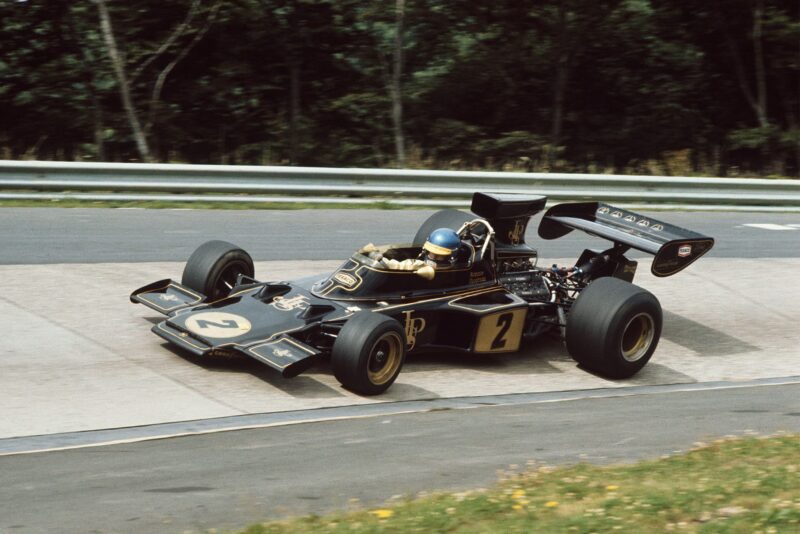
Ronnie Peterson was second to Stewart in qualifying
Motorsport Images
As everyone began to assemble in the pit area at midday on Friday a light summer rain began to fall and there was a bit of a rush back to the paddock to collect “rain” tyres. However, the rain did not develop, the track dried and the business of practice began, with spare cars for Stewart and Peterson standing by. With the long lap of the Nurburgring, taking just over 7 minutes to cover; there is a system whereby drivers can leave the pit road, take the South Turn, drive up the return leg behind the pits and then double back round a loop to rejoin the pit area, instead of setting off over the bridge and down the twists and turns of the Hatzenbach and away on the 22.835 kilometre lap. This “loop” provides two things; an opportunity to try the car before leaving the pit area irrevocably, and the means for getting an officially timed lap without having to go all the way round the circuit beforehand.
The time-keepers are situated before the pits, so that as cars leave their pit they are not “seen” or timed until they have been all the way round. If the time-keepers were beyond the pits, the reverse would apply, any car ending a lap at the pits would not pass the timing line. On a short circuit of 1 min. 20 sec. these “untimed” laps are no worry, but on a 7-minute circuit they can absorb all the valuable practice time without showing any results. The “pits loop” obviates this, and also allows for a flying finish at the end of a lap, without the necessity to go all the way round again on a “slowing down” lap. At every first practice session at the Nurburgring there is always a reluctance to make the irrevocable decision to set off round the full lap, so that the dicing round and round the loop seems to go on interminably.
One of the first drivers to get on with the job was lckx in the third of the McLaren team cars, and he was setting competitive lap times before some drivers had even got out on the “pits loop”. The fastest lap ever made on the Nurburgring was by Ickx in a Ferrari in practice last year when he recorded 7 min. 07.0 sec. so that 1973 was clearly going to see the Aces well below 7 min. 10 sec. and a close approach to 7 minutes was not beyond the realms of possibility, while hopeful people even thought the 7-minute barrier might be broken. As it would represent an average speed of over 120 m.p.h. the occasion was looked forward to with great interest, but prematurely as it turned out. For a time there was a pretty lethargic air about the place, with people turning laps in 7 min. 20 sec. as the best, and mostly nearer 7 min. 30 sec., until lckx got the feel of the McLaren M23 and went round in 7 mins. 09.7 sec.
Just as he was getting wound up the Cosworth V8 engine broke and he abandoned the car out on the circuit. There was a short break in practice while the car was retrieved and during this time everyone seemed to wake up and some of them “got their skates on”, with the result that Stewart, Peterson, Cevert, and Lauda all got below “bogey” time and the Scot was only one tenth of a second off the unofficial record time. The performance by Lauda was particularly courageous, making the other BRM performers look a bit hopeless, but it was achieved more by enthusiasm than skill, for the young Austrian continues to arrive at corners too fast and leave them too slowly, instead of the reverse, which produces smoother, cleaner and faster driving. As always it was the regular group at the top and the usual ones at the bottom, with the Surtees team in trouble with a misfiring engine on the car of Mass, and Hailwood having a front wheel break its centre as he was plunging down the Fuchsrohe, fortunately with no dire results. Follmer’s Shadow had the side plate tear off its rear aerofoil and Ganley crashed his Williams into the guard-rails and crumpled the cockpit area very severely, quite beyond immediate repair.
On Saturday there were small rain clouds drifting across the Eifel mountains, every now and then dropping their load on different parts of the circuit, so that all hope of any superfast times was gone before practice got under way. For a long while everyone went round and round the “pits loop” until finally Purley was the first to make a breakaway and set off on a full lap. Stewart had a careful go round in the spare Tyrrell on “rain” tyres, and Lauda set off with a new type of air box on his BRM engine. Ickx was soon flying round, trying to make up for lost time, and poor Hailwood seemed to be fighting a losing battle with his Surtees, which looked to be all floppy at the back end. In contrast Mass was looking fast and stable, his car having 1972 suspension at the back, and the Lotus 72s, the McLarens, and the Tyrrells were all looking exactly as one would expect, fast and stable. All this was observing on the downhill twisty bit from the North Curve to Hatzenbach, where the brave ones had the throttle down on the stop, and the not-so-brave were “feathering”.
To keep a sense of proportion it is worth remembering that the average sporting driver in a normal car would go down this part of the Nurburging with the brakes on most of the time. The intermittent rain showers put a stop to any heroics being performed, but Ickx got a lap in at 7 min. 10.3 sec., which was fastest of the day, no-one else approaching this sort of performance. In the Lotus camp Fittipaldi was far from being fit and took a very secondary position, while Peterson’s effort collapsed in a heap beside the road when a suspension ball-joint at the front broke.
Race
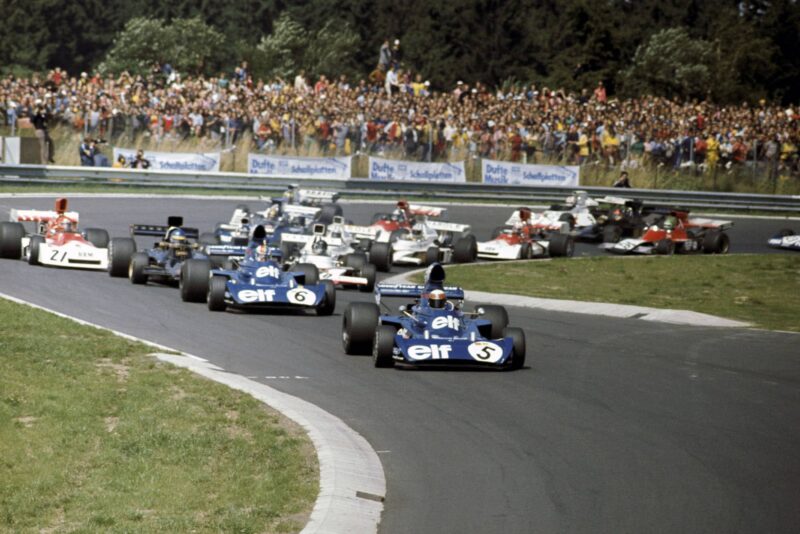
Stewart leads out of the first corner
Motorsport Images
When it was all over, and the starting grid sorted out from the two days practice, the result was anything but conclusive and an analysis of the grid without knowledge of what happened in practice would have given a completely false impression. On Sunday morning the Grand Prix cars had a short test session and the Grand Prix itself was due to start at 1 pm. The day was bright and sunny and the massacre of the public was over, for during the two days before the actual race the ambulance service was kept very busy by the sideshows. An FIA official caused bloodshed in the paddock by trying to ride a motorcycle at the wrong moment, one of the Formula One Union men was savaged by a bicycle, and a stunt-man fell into the crowd and caused a lot of damage.
The Grand Prix racers themselves did no damage to anyone at all! As the 22 starters left the pits to drive round the loop to the “dummy-grid” all was set fair for a clean and sporting German Grand Prix over 14 laps of the demanding Nurburgring. In spite of the width of the starting area, which used to contain four cars abreast, the field was lined up in pairs, slightly staggered to the right. Stewart and Peterson were side-by-side on the front row, with Ickx behind them and aimed between them, with Cevert on his right. In Germany the starting flag is raised, not dropped, and as it went up Cevert shot forward alongside Stewart, who promptly moved slightly left, close to Peterson and Ickx had nowhere to go. Down to the South Turn Peterson and the two Tyrrells were side-by-side, with Stewart nicely placed to chop across in front of the Swede, which he did. Cevert followed him through closely and the two blue cars cut across in front of the Lotus, leaving the Swede in third place, with Ickx in fourth place, and as far as there being a motor-race it was all over.
Away on the opening lap went Stewart, with Cevert shadowing him closely, followed by Peterson, Ickx, Lauda, Reutemann and the rest. Barely half-way round the first lap, as they plunged down to the lowest point of the circuit at Breidsheid, Peterson’s engine cut out and died completely with a major electrical fault and he pulled onto the grass and retired. On an intuition he had asked for his engine to be changed at the last moment before the race, and he now spent the rest of the day wishing he had left the “nuts and bolts” of racing to those who know about such things. As a race the German Grand Prix was all over by the time the two Tyrrells ended the first lap, for Stewart and Cevert were way ahead, even at a standing lap of 7 min. 27.5 sec., and Ickx was making no impression on them at all with the McLaren.
Long after everyone had gone by on the opening lap Beuttler arrived at the pits with his left-front tyre flat, and after having it changed he rejoined the race, such as it was. After Ickx had come Lauda (BRM), then Reutemann (Brabham), then Revson (McLaren), Pace (Surtees), Hulme (McLaren), Fittipaldi E. (Lotus), Fittipaldi W. (Brabham) and all the odds and sods. On the second lap as Lauda took the tight climbing right-hander at Bergwerk he felt there was something odd about the feel of his BRM, and while he was thinking about it and taking the flat-out swerves at Kesselchen he flew off the road and in a long accident completely demolished his BRM and broke his wrist. It all pointed to a deflating rear tyre, for BRMs have not been prone to breaking suspension members, wheels, or steering parts, like some cars. While all this was going on Beltoise had a completely flat left-rear tyre and was limping along to try and regain the pits.
Altogether it was a pretty momentous lap, for Revson lost control in the Hatzenbach swerves, bounced off a curb and hit the Armco barrier, but was able to continue, his McLaren suffering a badly buckled left-rear wheel rim, but the tyre was undamaged. This little excursion dropped him from sixth to fourteenth place, from which he never really recovered.
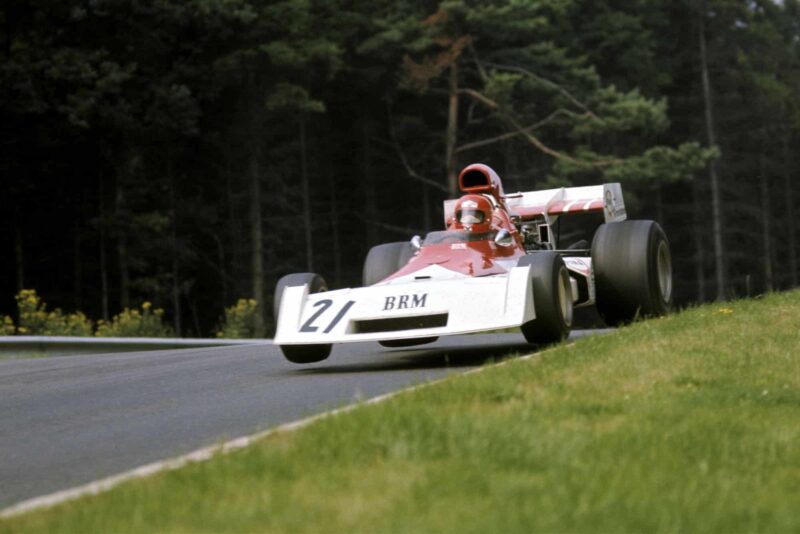
Niki Lauda takes flight on the Flugplatz
Motorsport Images
The two Tyrrells just drove off into the middle distance, neither Stewart nor Cevert putting a foot wrong, and they didn’t have to try too hard lapping at around 7 min 17.0. sec. to 7 min. 16.0 sec., gradually speeding up, but not approaching the old lap record of 7 min. 13.6 sec., let alone the practice times. Beltoise got back to the pits on his flat tyre, a new wheel and tyre were fitted, and he carried on, but on lap 5 the gearbox/final drive broke, no doubt havinging been over-strained while driving with a flat tyre. Follmer slid gently off the road at the North Turn on this lap and crashed his Shadow against the guard-rail and on the next lap Purley arrived at the pits with a flat left-rear tyre. Although Reutemann was in fourth place it was very obvious that he was holding everyone up, for lined up behind him and getting very agitated, were Pace (Surtees), Hulme (McLaren), Fittipaldi E. (Lotus), Fittipaldi W. (Brabham), Mass (Surtees), Regazzoni (BRM), and Pescarolo (Williams). At the end of lap seven as Reutemann arrived in the Start and Finish area officials almost poked a blue flag into his cockpit and, with a great rush, he let everyone by.
Before the end of the eighth lap the Argentinian was gone for good as his engine blew up, and Pace streaked away from the others who had been queueing-up behind the Brabham. At 10 laps the two Tyrrells had a 30-second lead over lckx, the Belgian being all on his own, and in fourth place was Pace, equally on his own; then came the Fittipaldi brothers racing in close company. E having the handicap of injured ankles, W being fit and healthy. Hulme followed them suffering from a tyre complex and handling that didn’t suit him, and then came Mass really enjoying himself. In ninth place was Oliver, revelling in a moment of glory at having overtaken Pescarolo, but more joyful at having got beyond the first lap. The rest struggled along behind, Hailwood having visited the pits to change the front tyres, for what good it prevailed him.
The only excitement that occurred was that the time-keepers automatically gave Stewart the fastest lap on lap eleven, in 7 min. 14.6 sec., and then were embarrassed to find that Pace had done 7 min. 14.4 sec. The Brazilian had no hope of winning, nor any hope of catching Ickx who was in third place, but he is one of those irresistible characters who just love driving fast. His Surtees was going well, he was feeling good, the circuit was perfect so he was like the proverbial hog in the fertilizer, and the result was another fastest lap and a new record on lap 12, in 7 mins. 13.2 sec., followed by an even better one on lap 13, in 7 min. 11.4 sec. Quite unconcerned, Stewart and Cevert cruised round in team formation, the two cars perfectly prepared and models of reliability and performance. Hulme stopped alter 12 laps to say his engine was making a funny noise, which was not-surprising as the rear exhaust pipe on the right-hand bank of his Cosworth V8 was no longer there, so he carried on making a very flat sound. Almost unbelievably, Graham Hill was still running nonstop, his pit crew wondering what to do with all the free-time at their disposal, and the Shadow works team were looking very puzzled for not only was Oliver still running, but he had now passed Revson and was quite a respectable eighth.
Almost without strain or emotion the two TyrreIls finished in a close first and second place, with Ickx trailing home in a worthy but unspectacular third place. Pace was fourth with a new lap record to his credit, and the Fittipaldi family were fifth and sixth, W before E. As a Tyrrell demonstration of power and domination it was first class, as a race it was unimpressive, and as an overall unspectacular German Grand Prix it had to be accepted; they can’t all be momentous or exciting races, and as regards unexpected excitement and emotion we have had enough for one season.
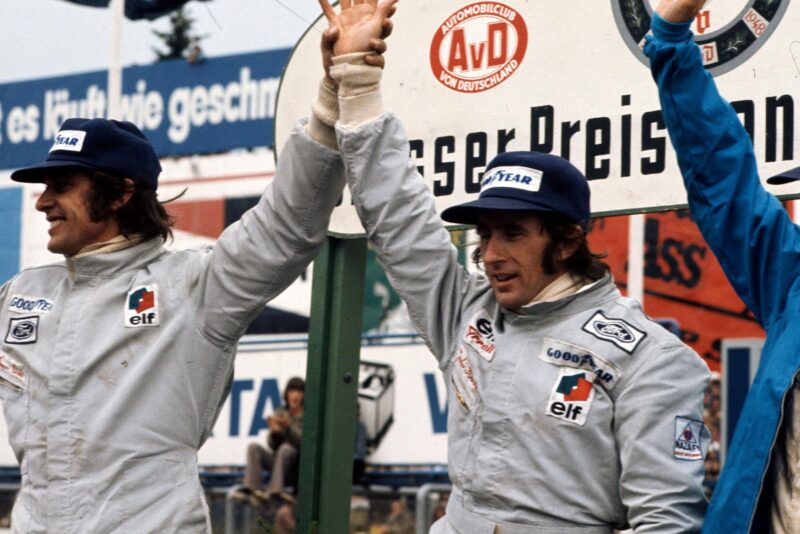
Jackie Stewart (right) and Francois Cevert celebrate on the podium
Motorsport Images
For the enormous crowd who took the opportunity for a glorious camping weekend it could not have been memorable, for the weather on Friday and Saturday made the Eifel mountains a bit soggy and muddy, but the campfires raged all weekend, the beer flowed and the sausages fried well, so the vast crowds who pay for it all were probably happy enough. The ELF Team Tyrrell were more than happy with a 1-2 on two successive weekends, the first by reason of a bit of luck, the second by sheer domination. – D.S.J.
